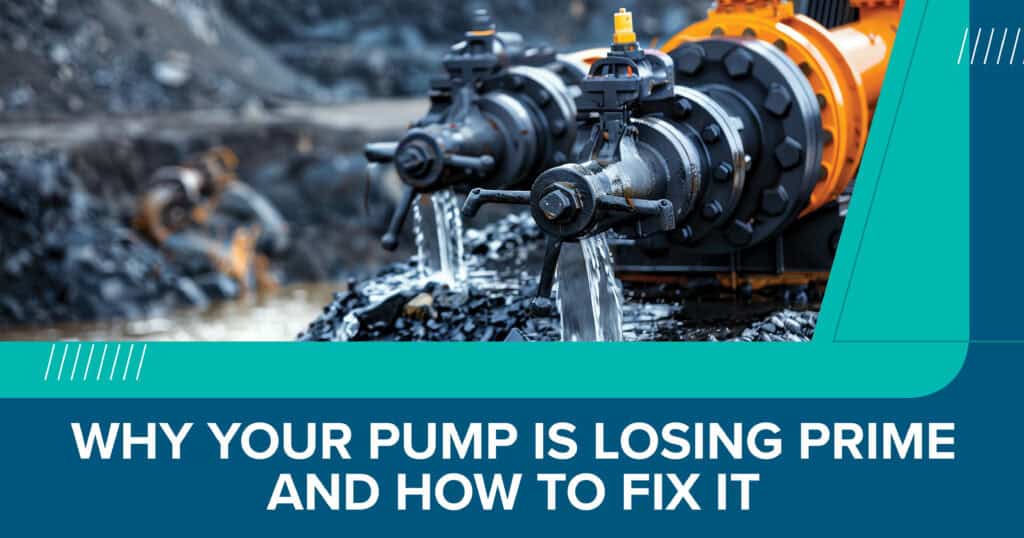When a pump loses prime, it stops functioning correctly. This leads to inefficiencies, potential equipment damage, and costly downtime for repairs. Maintaining prime ensures consistent fluid movement and prevents issues like cavitation or overheating. In this article, we’ll explore common causes of lost prime and how to troubleshoot and fix them.
What Is Pump Priming?
Priming a pump means removing air from the system so it can create the necessary suction to move liquid. Some pumps, such as self-priming models, can maintain prime automatically. Others require manual priming before operation. If a pump consistently loses prime, a system issue needs to be addressed.
Common Causes of a Pump Losing Prime
Air Leaks in the Suction Line
Even small leaks in the suction line can introduce air, preventing the pump from maintaining proper suction. Loose fittings, cracks in pipes, or worn gaskets can all contribute to this issue.
Low Water Levels or Dry Running
A pump needs a consistent fluid source. If the water level drops too low, the pump may start to suck in air and cause it to lose prime. Running a pump dry can also damage internal components.
Blocked or Clogged Suction Lines
Debris, sediment, or buildup in the suction line restricts flow, making it difficult for the pump to maintain prime. Common culprits include dirt, algae, and foreign objects.
Faulty Foot Valve or Check Valve
A malfunctioning foot or check valve allows water to drain back out of the pump, leading to loss of prime. These valves should close properly to keep fluid in the suction line when the pump is off.
Worn or Damaged Seals and Gaskets
Over time, pump seals and gaskets wear out. This generally leads to air leaks that disrupt priming. Inspecting and replacing these components regularly prevents issues.
Incorrect Priming Procedure
If a pump isn’t primed correctly, it won’t develop the suction needed to pull fluid. Ensuring the correct amount of liquid is introduced into the system before start-up is crucial.
How to Fix a Pump That Loses Prime
Step 1: Check for Air Leaks
The first step in troubleshooting a pump that loses prime is to check for air leaks. Inspect all fittings, connections, and hoses for cracks or loose components. A simple way to detect leaks is to apply soapy water to suspected areas. If bubbles form, air is escaping and disrupting the priming process.
Step 2: Clear Blockages
Next, clear any blockages that may be restricting flow. Remove the suction line and inspect it for clogs caused by debris, sediment, or algae buildup. Cleaning out these obstructions will restore proper fluid movement and improve suction.
Step 3: Inspect and Replace Valves
After clearing the suction line, inspect the foot and check valves. These components prevent backflow and ensure the suction line remains full of fluid when the pump is off. If a valve is worn out, clogged, or not sealing properly, replacing it can often resolve priming issues.
Step 4: Ensure Proper Priming
Ensuring proper priming is also crucial. Always follow the manufacturer’s recommended priming procedure to fill the pump with liquid before operation. If the pump is self-priming, verify the priming chamber contains enough fluid to function correctly.
Step 5: Maintain Adequate Water Levels
Finally, maintaining adequate water levels is essential for consistent pump operation. Regularly monitor the fluid source and ensure it does not drop too low, as this can cause the pump to take in air instead of liquid. Installing a float switch or sensor can prevent dry running and maintain optimal performance.
Prevent Future Priming Issues
Regular maintenance is key to preventing priming issues. Inspecting and tightening pump connections periodically can identify potential air leaks before they cause problems. Keeping suction lines clean is equally important, as debris buildup can restrict flow and disrupt priming. Flushing the system regularly ensures smooth operation and minimizes blockages.
Additionally, using the right pump for your application can prevent unnecessary performance issues. Pumps should be selected based on the specific operating conditions and fluid type to ensure they function efficiently. By staying proactive with maintenance and choosing the appropriate equipment, you can significantly reduce the risk of losing prime and extend the life of your pump.
Need Assistance? Contact DXP Pacific!
If your pump continues to lose prime despite troubleshooting, DXP Pacific is here to help. Our experts provide pump repair, maintenance, and system optimization to keep your equipment running optimally. Contact us today for professional support and customized solutions!

